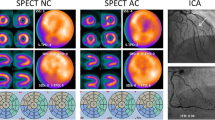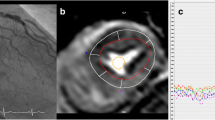Abstract
Background
Diagnostic assessment of myocardial perfusion impacts the management of patients with suspected coronary artery disease (CAD). Although various image displays are available for single photon emission computed tomography (SPECT) interpretation, the effects of display differences on SPECT interpretation remain undetermined.
Methods and Results
We studied 183 patients undergoing SPECT, including 131 consecutive patients referred for angiography and 52 at low CAD risk. Studies were visually interpreted by use of color and gray images, with readers blinded to the results of the other display. In accordance with established criteria, a summed stress score (SSS) of 4 or greater was considered abnormal. The prevalence of abnormal SPECT findings was higher with gray images than with color images (54% vs 48%, P<.001) based on a uniform criterion (SSS≥4). However, color images yielded equivalent sensitivity (79% vs 82%, P=.7) and improved specificity for global (50% vs 33%, P=.02) and vessel-specific CAD involving the right coronary artery (P<.01) and left anterior descending artery (P<.05). When the criterion for gray images was adjusted upward (SSS≥5) to reflect increased mean defect severity (SSS of 5.1 vs 4.4, P=.01), gray and color images provided equivalent sensitivity and specificity for global and vessel-specific CAD.
Conclusions
SPECT interpretation can vary according to image display as a result of differences in perfusion defect severity. Adjustment of abnormality criteria for gray images to reflect minor increases in defect severity provides equivalent diagnostic performance of gray and color displays for CAD assessment.
Similar content being viewed by others
References
Hachamovitch R, Berman DS, Kiat H, Cohen I, Cabico JA, Friedman J, et al. Exercise myocardial perfusion SPECT in patients without known coronary artery disease: incremental prognostic value and use in risk stratification. Circulation 1996;93:905–14.
Hachamovitch R, Berman DS, Kiat H, Cohen I, Lewin H, Amanullah A, et al. Incremental prognostic value of adenosine stress myocardial perfusion single-photon emission computed tomography and impact on subsequent management in patients with or suspected of having myocardial ischemia. Am J Cardiol 1997;80:426–33.
Vanzetto G, Ormezzano O, Fagret D, Comet M, Denis B, Machecourt J. Long-term additive prognostic value of thallium-201 myocardial perfusion imaging over clinical and exercise stress test in low to intermediate risk patients: study in 1137 patients with 6-year follow-up. Circulation 1999;100:1521–7.
Shaw LJ, Hachamovitch R, Berman DS, Marwick TH, Lauer MS, Heller GV, et al. The economic consequences of available diagnostic and prognostic strategies for the evaluation of stable angina patients: an observational assessment of the value of precatheterization ischemia. Economics of Noninvasive Diagnosis (END) Multicenter Study Group. J Am Coll Cardiol 1999;33:661–9.
Borges-Neto S, Mahmarian JJ, Jain A, Roberts R, Verani MS. Quantivative thallium-201 single photon emission computed tomography after oral dipyridamole for assessing the presence, anatomic location and severity of coronary artery disease. J Am Coll Cardiol 1988;11:962–9.
Segall GM, Atwood JE, Botvinick EH, Dae MW, Lucas JR. Variability of normal coronary anatomy: implications for the interpretation of thallium-SPECT myocardial perfusion images in single-vessel disease. J Nucl Med 1995;36:944–51.
Kang X, Berman DS, Lewin HC, Miranda R, Agafitei R, Cohen I, et al. Comparative localization of myocardial ischemia by exercise electrocardiography and myocardial perfusion SPECT. J Nucl Cardiol 2000;7:140–5.
Candell-Riera J, Santana-Boado C, Bermejo B, Armadans L, Castell J, Casans I, et al. Interhospital observer agreement in interpretation of exercise myocardial Tc-99m tetrofosmin SPECT studies. J Nucl Cardiol 2001;8:49–57.
Berman DS, Kiat H, Friedman JD, Wang FP, van Train K, Matzer L, et al. Separate acquisition rest thallium-201/stress technetium-99m sestamibi dual-isotope myocardial perfusion single-photon emission computed tomography: a clinical validation study. J Am Coll Cardiol 1993;22:1455–64.
Bogaty P, Guimond J, Robitaille NM, Rousseau L, Simard S, Rouleau JR, et al. A reappraisal of exercise electrocardiographic indexes of the severity of ischemic heart disease: angiographic and scintigraphic correlates. J Am Coll Cardiol 1997;29:1497–504.
Pereztol-Valdes O, Candell-Riera J, Santana-Boado C, Angel J, Aguade-Bruix S, Castell-Conesa J, et al. Correspondence between left ventricular 17 myocardial segments and coronary arteries. Eur Heart J 2005;26:2637–43.
Diamond GA, Forrester JS. Analysis of probability as an aid in the clinical diagnosis of coronary-artery disease. N Engl J Med 1979;300:1350–8.
Slomka PJ, Fish MB, Lorenzo S, Nishina H, Gerlach J, Berman DS, et al. Simplified normal limits and automated quantitative assessment for attenuation-corrected myocardial perfusion SPECT J Nucl Cardiol 2006;13:642–51.
Garcia EV, Cooke CD, Van Train KF, Folks R, Peifer J, DePuey EG, et al. Technical aspects of myocardial SPECT imaging with technetium-99m sestamibi. Am J Cardiol 1990;66:23E-31E.
Hansen CL, Goldstein RA, Berman DS, Churchwell KB, Cooke CD, Corbett JR, et al. Myocardial perfusion and function single photon emission computed tomography. J Nucl Cardiol 2006;13:e97–120.
Cerqueira MD, Weissman NJ, Dilsizian V, Jacobs AK, Kaul S, Laskey WK, et al. Standardized myocardial segmentation and nomenclature for tomographic imaging of the heart: a statement for healthcare professionals from the Cardiac Imaging Committee of the Council on Clinical Cardiology of the American Heart Association. Circulation 2002;105:539–42.
Gibbons RJ, Abrams J, Chatterjee K, Daley J, Deedwania PC, Douglas JS, et al. ACC/AHA 2002 guideline update for the management of patients with chronic stable angina—summary article: a report of the American College of Cardiology/American Heart Association Task Force on Practice Guidelines (Committee on the Management of Patients With Chronic Stable Angina). Circulation 2003;107:149–58.
Berman DS, Abidov A, Kang X, Hayes SW, Friedman JD, Sciammarella MG, et al. Prognostic validation of a 17-segment score derived from a 20-segment score for myocardial perfusion SPECT interpretation. J Nucl Cardiol 2004;11:414–23.
Wackers FJ, Sodenheimer M, Fleins JL, Brown M. Factors affecting uniformity in interpretation of planar thallium-201 imaging in a multicenter trial. The Multicenter Study on Silent Myocardial Ischemia (MSSMI) Thallium-201 Investigators. J Am Coll Cardiol 1993;21:1064–74.
Klocke FJ, Baird MG, Bateman TM, Carabello BA, Cerqueira MD, DeMaria AN, et al. ACC/AHA/ASNC guidelines for the clinical use of cardiac radionuclide imaging: a report of the American College of Cardiology/American Heart Association Task Force on Practice Guidelines (ACC/AHA/ASNC Committee to Revise the 1995 Guidelines for the Clinical Use of Radionuclide Imaging). American College of Cardiology Web site, 2003, Available from: URL: http://www.acc.org/clinical/guidelines/radio/rni_fulltext.pdf
Johansen A, Hoiland-Carlsen PF, Christemen HW, Vach W, Jorgensen HB, Veje A, et al. Diagnostic accuracy of myocardial perfusion imaging in a study population without post-test referral bias. J Nucl Cardiol 2005;12:530–7.
Rodes-Cabau J, Candell-Riera J, Angel J, de Leon G, Pereztol O, Castell-Conesa J, et al. Relation of myocardial perfusion defects and nonsignificant coronary lesions by angiography with insights from intravascular ultrasound and coronary pressure measurements. Am J Cardiol 2005;96:1621–6.
Verna E, Ceriani L, Giovanella L, Binaghi G, Garancini S. “Falsepositive” myocardial perfusion scintigraphy findings in patients with angiographically normal coronary arteries: insights from intravascular sonography studies. J Nucl Med 2000;41:1935–40.
Machecourt J, Longere P, Fagret D, Vanzetto G, Wolf JE, Polidori C, et al. Prognostic value of thallium-201 single-photon emission computed tomographie myocardial perfusion imaging according to extent of myocardial defect. Study in 1,926 patients with follow-up at 33 months. J Am Coll Cardiol 1994;23:1096–106.
Slomka PJ, Nishina H, Berman DS, Akincioglu C, Abidov A, Friedman JD, et al. Automated quantification of myocardial perfusion SPECT using simplified normal limits. J Nucl Cardiol 2005;12:66–77.
Iskander S, Iskandrian AE. Risk assessment using single-photon emission computed tomographic technetium-99m sestamibi imaging. J Am Coll Cardiol 1998;32:57–62.
Author information
Authors and Affiliations
Corresponding author
Additional information
Dr Weinsaft was the recipient of a Doris Duke Clinical Scientist Development Award from the Doris Duke Charitable Foundation (New York, NY)
Rights and permissions
About this article
Cite this article
Weinsaft, J.W., Gade, C.L., Wong, F.J. et al. Diagnostic impact of SPECT image display on assessment of obstructive coronary artery disease. J Nucl Cardiol 14, 659–668 (2007). https://doi.org/10.1016/j.nuclcard.2007.06.115
Received:
Accepted:
Issue Date:
DOI: https://doi.org/10.1016/j.nuclcard.2007.06.115




